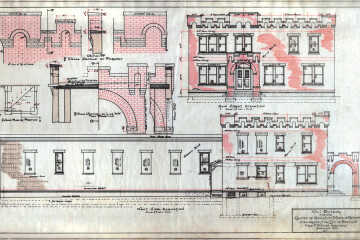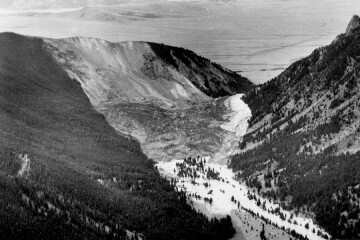Gallatin Valley Female Seminary: Polite Education in the Early Gallatin Valley
Every fall for the last 150 years, school bells have been calling students back to their studies. None more so than down the valley to the Manhattan area settlements like Churchill and Amsterdam. However, the small settlement of Hamilton would even boast of its own school, the Gallatin Valley Female Seminary. Some people believe that the seminary was the only school of its kind in the entirety of the Montana Territory at the time. The Gallatin Valley Female Seminary would prove to be a popular alternative to the fledgling public education system in the mid-nineteenth century Gallatin Valley.
Reverend Lyman B. Crittenden arrived in the settlement of Bozeman in late September of 1872. He intended on becoming established as the pastor at the Presbyterian Church and also planned to establish a Presbyterian seminary in the area. Reverend Crittenden would come to Bozeman from Corine, Utah where he was employed as a full-time reverend. However, his health soon faltered due to exhaustion and he needed something less strenuous. Embarking on the journey to Bozeman, Reverend Crittenden decided that with the help of his daughter, Mary Gertrude, a teaching experience would be less wearisome than that of a full-time pastorate.

The Bozeman Avant-Courier announced the new arrivals and their plans for the seminary in an issue from September 19, 1872. “Will do more for the improvement and substantial prosperity of our town is the contemplated seminary which we (have) no doubt…will be built without delay.” The news of a Protestant seminary was welcomed by the Ladies Board of Missionaries of the Presbyterian Church. They declared in their annual reports that, “We have also one school in Montana, the only Protestant school in the Territory, and the only opposition to the Roman Catholic Sisters, which has been deemed of so much importance as to be taken under the care of the Presbytery.” With so much anticipation for the school and support from the area and the nation, the school opened in Bozeman in October of 1872 at the corner of Tracy and Olive in the “Good Templars Hall.” Soon after the initial opening, the school was moved to a log cabin on West Main Street.
When the school opened in the late fall of 1872, the staff was made up of four people: Reverend Lyman Crittenden as the Superintendent, Miss Mary Gertrude Crittenden as the Principal, Miss Ella Aylesworth as the Assistant Teacher and Mrs. Crittenden as the Matron and Drawing teacher. The course of study for both the girls’ and boys’ included classes in reading, writing, history, geography, arithmetic and drawing. As the students grew older and advanced beyond the eighth grade they were eligible to take advanced courses in astronomy, algebra, and philosophy. For the pleasure of attending these classes at the seminary, students who boarded had to come up with a payment of $20 per month. Day scholars paid $4 per month. These prices did not include extra services such as; “teaching French or German, instrumental music, stationary, or material for ornamental work or washing.”
Much like the modern day economic recessions, the Panic of 1873 put a clamp on the Seminary and its ability to operate and “give Christian education to the young people of Bozeman and the vicinity.” However, during that year the Ladies Society sent the seminary a piano. Miss Crittenden was said to have played the piano and sang very well. The addition of the instrument proved to be a welcomed addition to the curriculum and the community as a whole.

The Crittenden family decided to move the seminary to a cheaper place in the Gallatin Valley known as the Culver Place in 1874. Culver Place was located near the settlement of Hamilton, Montana about two miles from the present day Manhattan. Mary Crittenden described the settlement of Hamilton as “a typical western town, one store, a blacksmith shop, a school house, and two or three dwellings. However, it had no saloon.” The new seminary campus consisted of a log building of two stories and a low log building with a domed shape stone cellar. It was at this point that the seminary was converted to a girls’ only facility and took the name “Gallatin Valley Female Seminary.”
The work of Reverend Crittenden, his family, and Ella Aylesworth did not go unnoticed by the sponsoring organization, Ladies Missionary Society of the First Presbyterian Church of New York. The Annual Report of the society in 1874 revealed the feelings toward Miss Crittenden’s school. “Miss Crittenden’s Protestant School in Montana territory opens this year with even greater promise than before. The location of the school has been moved to Hamilton, twenty miles from Bozeman, but the change has been of advantage to the enterprise in many ways. It offers the true and effectual opposition to the insidious teachers of the Romish Sisters.” The society awarded the Seminary with a contribution of $100. Mary Crittenden also reflected the optimism of the Ladies Society in her writings. “Of the past year I may speak with more grateful satisfaction that any previous one. Our pupils are all steadily and perceptibly advancing in knowledge and true culture, and we hope in Christian principle. We have every prospect for the coming years as a barrier to the pernicious influences of Catholic teachings, the importance of this school cannot be over-estimated, and we expect to continue its support.”
The move to Culver Place saw the enrollment of the school grow to roughly 25 pupils. Many of these pupils were between the ages of 12 and 17 years of age and came mainly from the Gallatin Valley area. Many of the classes remained the same for the students. The underlying religious curriculum of the school was recognized throughout the Hamilton area. An average day for the girls at the seminary was outlined by Ms. Crittenden, “Breakfast at 6, family worship at 6:30, scripture and lessons beginning at 9, noon hour for lunch and chit chat, lessons at scripture until 5:30, family gathering at the table at 5:30, recreation until 7, study in rooms until 9 and end the day at evening worship.” The community generally supported the activities of the school. However, one young farmer had this to say about the school, “When I haul hay on Sunday, I’ll go two or three miles out of my way rather than drive past the Seminary.”
Thanksgiving Day 1875 saw the school embarked on one more move from “Culver Place” to “Drew Place”. The common rationale for this move was to take advantage of a favorable location. “Drew Place” was located halfway between Hamilton and Central Park and sat along the stage road between Helena and Bozeman. Most of the girls, with one exception, made the move from Culver Place to Drew Place. The one exception to the move was a student by the name of Blanche Thorpe, who died during the stay at Culver Place. All total between the group of girls that came from “Culver Place” and the new recruits, the school saw its enrollment reach 35.
As the school settled in at “Drew Place”, Reverend Crittenden began work on building a church to be used in connection with the school. A kindly neighbor by the name of Henry Heebe donated a plot of land to the school in order to construct a church. Fundraising proved to be a fairly simple affair as the Bozeman Avant Courier stated, “The building will be 24x26, and the cost is estimated at about $1800. About $1000 of that sum has already been subscribed by the good people of Gallatin County, and Mr. Crittenden is confident in raising the balance.” By the end of 1877, the church was constructed alongside the school house at “Drew Place”.
The school continued educating students through the school year of 1877-1878. The teacher, Ms. Mary Gertrude Crittenden, wed Edward Davidson on July 4, 1878. The wedding took place under the trees outside of the church and school at Drew Place. The Avant Courier described the day as, “Last Wednesday was a beautiful day…The air was invigorating, the sky clear, and the early sun as bright as ever.” The bridal party consisted of the students at the school as well as the assistant teacher, Ms. Ella Aylesworth. Due to the customs of the time, Ms. Crittenden was forced to step down as teacher at the school to attend to her new husband and home. The school was then forced to close its doors and the Gallatin Valley Female Seminary no longer educated the young ladies of the Gallatin Valley.
Michael Herdina is the state coordinator for Montana National History Day. He also works as the Director of Outreach and Development for the Gallatin History Museum.

